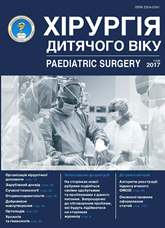The advantages of one-stage orchiopexy compared to other laparoscopic surgery for the treatment of abdominal form of cryptorchidism in children
DOI:
https://doi.org/10.15574/PS.2017.54.76Keywords:
cryptorchidism, children, laparoscopy, treatmentAbstract
Objective: to improve the results of diagnosis and treatment of patients with intra-abdominal cryptorchidism by developing a new approach to surgical treatment with the introduction of laparoscopic technique and live tissue welding technology; to conduct a comparative analysis of the performed surgery using the various laparoscopic techniques in children with this condition; to analyze the long-term results by testicular ultrasonography in different age groups.
Materials and methods. The paper summarizes experience of treating of 119 patients with suspected intra-abdominal cryptorchidism, who were admitted to the surgical department of the Zhytomyr Region Children’s Clinical Hospital between 2000 and 2015. The interventions were performed using the laparoscopy of the company «Karl Storz», pediatric model, and apparatus for live tissues welding. Anaesthetic stations that was using during surgical interventions: FELIX VISIO Integra and Leon MEIMEN-LOVENSTEIN). Ultrasound examinations were carried out by using the ultrasound devices with Doppler effect («Philips HD 11XL» with color Doppler and «Siemens G50» with color Doppler) that permitted to assess the state of scrotum, spermatic cord and testicles blood circulation before surgery. The diagnosis of testicular hypoplasia (by measuring its width and length) was conducted by the method of Vasiliev A. et al., 2008.
Results. The study included 29 children (24%) who underwent one-stage orchiopexy. In total 43 (36%) children who were operated with single stage Fowler-Stephens orchiopexy. The video-assisted orchipexy (combination of diagnostic laparoscopy plus inguinal access) was applied in 23 (19.5%) children. The 24 cases that makes up 20.5%, when the testicles were not vizualised intraabdominally or hypoplasia, aplasia or anorhizm was detected during the intervention, were excluded from the comparative analysis of surgical methods.
Conclusions. Comprehensive assessment of the treatment efficacy of children with intra-abdominal cryptorchidism in index and control groups showed that the one-stage orchiopexy with using the tissue preservation high-frequency live tissue welding permitted to significantly improve the outcomes in patients with this pathology, since testicular hypoplasia was observed only up to six months of age in two patients (total 29 patients, p<0.05), and after one year of age was not identified in any case. The follow-up showed that resistance index, PSV and EDV in all groups of patients up to one year of age were within normal limits. Thus, the study of the efficacy of surgical treatment of patients with intra-abdominal cryptorchidism demonstrated the advantage of one-stage laparoscopic orchiopexy combined with with live tissue welding technique.
References
Vasilev AYu, Olhova EB. 2008. Ultrazvukovaya diagnostika v detskoy andrologii i ginekologii. Moskva, GEOTAR–Mediya: 79–83.
Halinskyi YeIu, Mohyliak OI, Tolstanov OK ta in. 2005. Vykorystannia endovideokhirurhii diahnostytsi ta likuvanni cherevnoi formy kryptorkhizmu u ditei. Khirurhiia dytiachoho viku. 2: 20–23.
Tolstanov OK, Rusak PS, Shevchuk DV, Belei RP. 2010.Vykorystannia endovideokhirurhii u diahnostytsi ta likuvanni cherevnoi formy kryptorkhizmu u ditei. Khirurhiia dytiachoho viku. 3: 19–22.
Voloshyn YuL. 2014. Suchasni pidkhody v diahnostytsi ta likuvanni abdominalnoi formy kryptorkhizmu v ditei. Khirurhiia dytiachoho viku. 1–2: 107–111.
Voloshyn YuL. 2015. Khirurhichne likuvannia yaiechok, shcho ne palpuiutsia, u ditei. Khirurhiia dytiachoho viku. 3–4(48–49): 100–106.
Horbatiuk OM. 2011. Neopushcheni yaiechka u novonarodzhenykh. Neonatolohiia, khirurhiia ta perynatalna medytsyna. 2: 62–65.
Dronov AF, Poddubniy IV, Kotlobovskiy VN. 2002. Endoskopicheskaya hirurgiya u detey. Moskva, ID «GEOTAR-med»: 440.
Rusak PS, Danylov OA, Kukuruza YuP, Rybalchenko VF. 2006. Laparoskopichna khirurhiia dytiachoho viku. Navchalno-metodychnyi posibnyk. Zhytomyr–Kyiv, NMAPO im PL Shupyka, VNMU im MI Pyrohova: 128.
Rusak PS, Pereiaslov AA, Shevchuk DV et al. 2012. Mistse maloinvazyvnykh tekhnolohii v diahnostytsi ta likuvanni cherevnoi formy kryptorkhizmu u ditei. Halytskyi likarskyi visnyk. 19; 3: 100–101.
Tolstanov OK, Danylov OA, Rusak PS, Voloshyn YuL. 2012. Osoblyvosti likuvannia abdominalnoi formy kryptorkhizmu. Khirurhiia dytiachoho viku. 3: 34–37.
Rusak PS, Voloshyn YuL, Shevchuk DV, Daleka MV. 2015. Shchodo pytannia diahnostyky ta likuvannia cherevnoi formy kryptorkhizmu u ditei. Khirurhiia dytiachoho viku. 1.
Cortes D, Thorup J, Petersen B. 2004. Testicular neoplasia in undescended testes of cryptorchid boys-does surgical strategy have an impact on the risk of invasive testicular neoplasia? Til urk J Pediatr. Suppl 35–42: 46.
Loarca EA, Ortega ES. 2005. Is necessary to practice orchiectomy in patients with post-puberal maldescended testes. Actas Urol Esp. 29(10): 969–973.
Coveney D, Shaw G, Hutson M, Renfree M. 2002. The development of the gubernaculum and inguinal closure in the marsupial. Anat. 201: 239–256.
Downloads
Issue
Section
License
The policy of the Journal “PAEDIATRIC SURGERY. UKRAINE” is compatible with the vast majority of funders' of open access and self-archiving policies. The journal provides immediate open access route being convinced that everyone – not only scientists - can benefit from research results, and publishes articles exclusively under open access distribution, with a Creative Commons Attribution-Noncommercial 4.0 international license(СС BY-NC).
Authors transfer the copyright to the Journal “PAEDIATRIC SURGERY.UKRAINE” when the manuscript is accepted for publication. Authors declare that this manuscript has not been published nor is under simultaneous consideration for publication elsewhere. After publication, the articles become freely available on-line to the public.
Readers have the right to use, distribute, and reproduce articles in any medium, provided the articles and the journal are properly cited.
The use of published materials for commercial purposes is strongly prohibited.

